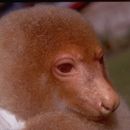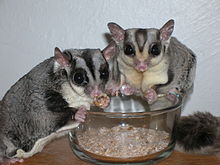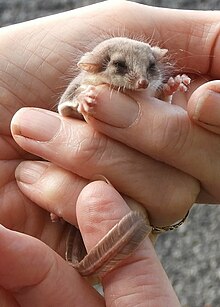ar
الأسماء في صفحات التنقل


Phalangeriformes /fəˈlændʒərɪfɔːrmiːz/ is a paraphyletic[1] suborder of about 70 species of small to medium-sized arboreal marsupials native to Australia, New Guinea, and Sulawesi.[2] The species are commonly known as possums, gliders, and cuscus. The common name "possum" for various Phalangeriformes species derives from the creatures' resemblance to the opossums of the Americas (the term comes from Powhatan language aposoum "white animal", from Proto-Algonquian *wa·p-aʔɬemwa "white dog"). However, although opossums are also marsupials, Australasian possums are more closely related to other Australasian marsupials such as kangaroos.
Phalangeriformes are quadrupedal diprotodont marsupials with long tails. The smallest species, indeed the smallest diprotodont marsupial, is the Tasmanian pygmy possum, with an adult head-body length of 70 mm (2+3⁄4 in) and a weight of 10 g (3⁄8 oz). The largest are the two species of bear cuscus, which may exceed 7 kg (15 lb 7 oz). Phalangeriformes species are typically nocturnal and at least partially arboreal. They inhabit most vegetated habitats, and several species have adjusted well to urban settings. Diets range from generalist herbivores or omnivores (the common brushtail possum) to specialist browsers of eucalyptus (greater glider), insectivores (mountain pygmy possum) and nectar-feeders (honey possum).


About two-thirds of Australian marsupials belong to the order Diprotodontia, which is split into three suborders, namely the Vombatiformes (wombats and the koala, four species in total); the large and diverse Phalangeriformes (the possums and gliders) and Macropodiformes (kangaroos, potoroos, wallabies and the musky rat-kangaroo). Note: this classification is based on Ruedas & Morales 2005. However, Phalangeriformes has been recovered as paraphyletic with respect to Macropodiformes, rendering the latter a subset of the former if Phalangeriformes are to be considered a natural group.[3][4]
Phalangeriformes /fəˈlændʒərɪfɔːrmiːz/ is a paraphyletic suborder of about 70 species of small to medium-sized arboreal marsupials native to Australia, New Guinea, and Sulawesi. The species are commonly known as possums, gliders, and cuscus. The common name "possum" for various Phalangeriformes species derives from the creatures' resemblance to the opossums of the Americas (the term comes from Powhatan language aposoum "white animal", from Proto-Algonquian *wa·p-aʔɬemwa "white dog"). However, although opossums are also marsupials, Australasian possums are more closely related to other Australasian marsupials such as kangaroos.
Phalangeriformes are quadrupedal diprotodont marsupials with long tails. The smallest species, indeed the smallest diprotodont marsupial, is the Tasmanian pygmy possum, with an adult head-body length of 70 mm (2+3⁄4 in) and a weight of 10 g (3⁄8 oz). The largest are the two species of bear cuscus, which may exceed 7 kg (15 lb 7 oz). Phalangeriformes species are typically nocturnal and at least partially arboreal. They inhabit most vegetated habitats, and several species have adjusted well to urban settings. Diets range from generalist herbivores or omnivores (the common brushtail possum) to specialist browsers of eucalyptus (greater glider), insectivores (mountain pygmy possum) and nectar-feeders (honey possum).